Red light therapy works for diabetic wounds by triggering multiple healing mechanisms in your body. It boosts ATP production in your cells' mitochondria, giving them more energy to repair damage. You'll benefit from increased blood flow and new blood vessel formation, which delivers essential oxygen and nutrients to wound sites. The therapy also reduces inflammation, fights oxidative stress, and stimulates collagen production through activated fibroblasts. It's particularly effective because it enhances cell migration to injury sites and promotes the release of growth factors that speed up healing. Understanding these powerful healing mechanisms can help you make informed decisions about your wound care options.
Understanding Red Light Basics
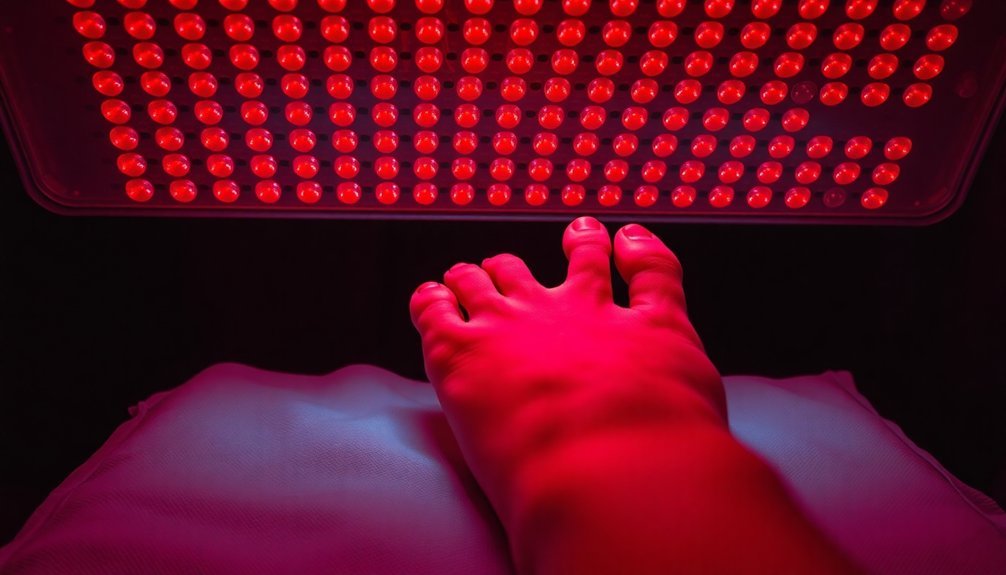
Light therapy pioneers discovered a powerful healing tool when NASA first developed red light therapy nearly five decades ago. This non-invasive treatment harnesses specific wavelengths of red and near-infrared light to trigger your body's natural healing processes without causing discomfort or side effects.
You'll find that red light therapy works similarly to photosynthesis in plants. When the light penetrates your skin, your cells can directly absorb and use this energy to power their repair and regeneration processes.
The treatment employs low-level wavelengths that reach deep into your tissue, where they stimulate cellular energy production and enhance metabolic functions. The light wavelengths typically range 600 to 1,000 nanometers, which is optimal for tissue penetration.
You can access red light therapy through various devices, from handheld wands for targeted treatment to full-body panels. If you're treating a small area, you'll want to use a compact device or wand that you can move across your skin.
For larger areas, wall-mounted or tabletop panels provide broader coverage. These devices deliver precise wavelengths of light that thousands of peer-reviewed studies have shown to be effective in promoting healing and reducing inflammation in damaged tissue.
Cell Repair Mechanisms
Red Light Therapy's remarkable impact on cell repair starts with boosted ATP production in your cells' mitochondria, giving them the essential energy needed to heal diabetic wounds.
You'll experience enhanced cell migration as the light penetrates damaged tissue, allowing cells to move more effectively to injury sites where they're needed most.
The therapy also helps repair mitochondrial DNA damage, which is particularly critical for diabetic patients whose cellular repair mechanisms are often compromised.
Through cytochrome c oxidase stimulation, the therapy triggers a cascade of healing responses at the cellular level to accelerate tissue regeneration.
ATP Production and Energy
ATP-vesicles step up cellular repair mechanisms by delivering energy directly where it's needed most. When these vesicles enter your cells, they jumpstart tissue regeneration within 24 hours of treatment, bypassing the traditional healing lag time. You'll see rapid macrophage proliferation and direct collagen production, which creates a faster path to recovery. Studies involving more than 200 rabbits demonstrated consistent success in achieving rapid tissue regeneration without scarring.
| Cellular Process | ATP-Vesicle Effect | Clinical Outcome |
|---|---|---|
| Macrophage Activity | Increases in-situ proliferation | Enhanced tissue repair |
| Collagen Production | Direct synthesis activation | Faster matrix formation |
| Protein Expression | Upregulates MCP-1, IL-6, IL-10 | Improved healing signals |
| Matrix Formation | Bypasses provisional matrix | Reduced healing time |
Your cells maintain higher energy levels through this targeted ATP delivery, enabling them to produce collagen type 1α1 for extended periods. This sustained energy boost creates a unique healing environment that prevents excessive scarring while promoting rapid tissue regeneration. Unlike traditional treatments or laser therapy, ATP-vesicles work directly at the cellular level, providing immediate energy for repair processes. This targeted approach particularly benefits diabetic wounds, where energy metabolism is often compromised.
Mitochondrial DNA Repair
While cellular energy production drives healing, the integrity of mitochondrial DNA plays a central role in wound recovery. In diabetic wounds, high glucose levels trigger oxidative stress that damages your mitochondrial DNA (mtDNA), leading to impaired healing. This damage shows up as increased 8-OHdG markers and specific DNA deletions that compromise your cells' ability to function properly. The mtDNA is particularly vulnerable, being 10-20 times more susceptible to oxidative damage compared to nuclear DNA.
Your body has several repair mechanisms to protect mtDNA, including base excision repair (BER), mismatch repair (MMR), and homologous recombination. However, diabetes interferes with these repair pathways, making it harder for your cells to fix mtDNA damage.
When you can't repair this damage effectively, your mitochondria can't produce energy properly, further slowing wound healing.
You'll get better results if you address mtDNA damage early. While insulin treatment can quickly normalize some damage markers, it can't reverse existing mtDNA deletions. That's why early intervention is vital.
Scientists are now exploring new ways to enhance mtDNA repair, including antioxidant therapies and treatments that target mitochondrial function directly. These approaches could substantially improve how your diabetic wounds heal.
Cell Migration Enhancement
During wound healing, your cells must actively migrate to the injury site to repair damaged tissue – a process that's substantially impaired in diabetic conditions. High glucose levels markedly slow down this cellular movement, but red light therapy can help overcome these limitations.
When you receive red light therapy, it enhances cell migration through multiple mechanisms. The therapy improves the survival and movement of mesenchymal stem cells (MSCs), which are vital for wound repair but typically struggle in high-glucose environments. These stem cells release beneficial compounds that promote healing through their paracrine function. The accumulation of reactive oxygen species severely impacts MSC survival in diabetic conditions.
You'll find that red and near-infrared light stimulate better vascularization, which is essential for wound healing. This improved blood vessel formation happens through enhanced interaction between endothelial cells and pericytes, leading to better oxygen and nutrient delivery to the wound site.
The therapy also reduces inflammation while promoting tissue repair, creating an environment that supports cellular movement.
Combined with other treatments like MSC-derived extracellular vesicles, red light therapy can substantially boost your body's natural healing processes by improving cell migration and proliferation, making it an effective treatment option for diabetic wounds.
Blood Flow Enhancement
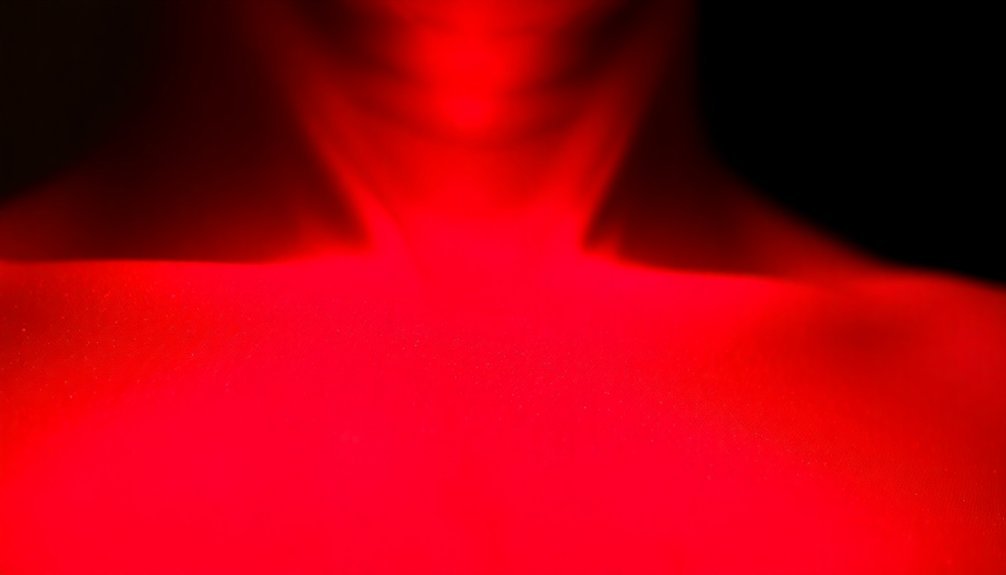
Red light therapy substantially enhances blood flow in diabetic wounds through multiple interconnected mechanisms. When you receive this treatment, it triggers the production of vascular endothelial growth factor (VEGF), which stimulates the formation of new blood vessels. This process, known as angiogenesis, creates essential pathways for oxygen and nutrients to reach your wound site.
The therapy's effects on microcirculation are particularly beneficial for diabetic wounds. Studies show that FIR-40 treatment groups demonstrate significantly better blood flow compared to lower-dose treatments. You'll experience improved blood flow in the smallest vessels, which is necessary since diabetes often compromises circulation. This enhancement is measurable through laser Doppler flowmetry, confirming the therapy's effectiveness in boosting skin blood flow.
Your cells will receive more oxygen through this improved circulation, which is critical for healing. The increased oxygen delivery helps reduce oxidative stress and inflammation while supporting the wound healing process.
Additionally, you'll benefit from enhanced cellular energy production as the therapy stimulates ATP production in your cells. This boost in cellular energy, combined with improved blood flow, activates fibroblasts that are important for wound closure and encourages the expression of important proteins like eNOS and EGF, further supporting the healing process.
Pain Relief Benefits
Beyond its circulation benefits, light therapy delivers significant pain relief for diabetic wound patients through multiple pathways. When red light penetrates your tissue, it triggers natural pain-relieving mechanisms in your body, including endorphin release and inflammation reduction.
You'll experience relief as the therapy modulates pain receptors while simultaneously promoting cellular healing and tissue repair. The treatment has shown remarkable success in stopping surface exudation, making it highly effective for managing wound-related discomfort.
Clinical evidence strongly supports these pain-relieving effects, with studies showing measurable reductions in pain markers and improved patient comfort. The therapy's ability to speed up wound closure directly contributes to shorter pain duration, while its cellular stimulation enhances your body's natural healing processes.
Here's how red light therapy specifically targets your pain:
- Stimulates ATP production in your cells, providing more energy for healing and reducing discomfort
- Triggers the release of natural pain-relieving compounds while decreasing inflammatory markers
- Promotes faster wound closure through enhanced cellular activity, which shortens the overall duration of pain
Through photobiomodulation, you'll benefit from both immediate pain relief and long-term healing effects, making this therapy particularly valuable for managing diabetic wound discomfort.
Scientific Research Findings
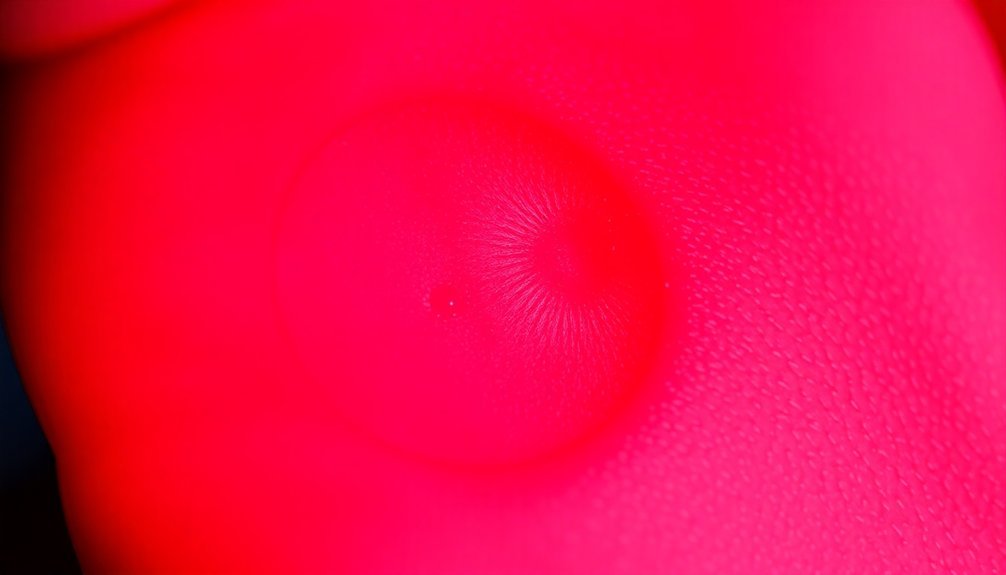
Clinical studies prove you'll experience faster wound healing when using red light therapy, as researchers have documented significant reductions in diabetic ulcer sizes and improved tissue repair rates.
Your body's cells respond to the treatment by increasing ATP production and enhancing the natural repair processes at the molecular level. The therapy activates cytochrome c oxidase in your cells, which is the primary photoacceptor for red and near-infrared light.
The scientific evidence continues to grow, showing that red light therapy promotes cellular regeneration, boosts collagen production, and accelerates wound closure through improved microcirculation.
Clinical Studies Show Results
Several breakthrough studies into the effectiveness of red light therapy have demonstrated remarkable healing mechanisms for diabetic wounds. You'll find that clinical research consistently shows how this therapy triggers multiple healing responses in your body, particularly beneficial for diabetic wound treatment.
The scientific evidence reveals that red light therapy works through three primary mechanisms that you can count on:
- It actively fights inflammation by reducing pro-inflammatory cytokines and CD45+ cells around your wound edges, which helps decrease pain and irritation that often accompanies diabetic wounds.
- You'll experience improved blood circulation as the therapy stimulates blood flow and promotes the formation of new blood vessels, essential for delivering healing nutrients to wounded areas.
- Your body's natural healing process accelerates as the therapy enhances cellular activity, specifically by activating fibroblasts that produce collagen and stimulating genes responsible for tissue repair.
These clinical findings show that you're not just getting temporary relief – you're receiving a scientifically-proven treatment that works at the cellular level to promote lasting healing through multiple pathways, making it particularly effective for managing diabetic wounds.
Cellular Repair Evidence Mounts
The latest scientific findings reinforce how red light therapy drives cellular repair at a microscopic level. When red light penetrates your skin, it triggers a process called photobiomodulation, where your cells' powerhouses increase their ATP production, providing more energy for healing.
You'll find that red light therapy works through multiple cellular mechanisms. It stimulates your fibroblasts, which are essential cells that produce collagen and help rebuild damaged tissue. The therapy also enhances your blood circulation at the microscopic level, delivering necessary oxygen and nutrients to wound sites while modulating nitric oxide levels to support vascular function.
The evidence shows that your cells respond to red light therapy by increasing their production of growth factors like VEGF and FGF. These proteins are fundamental for creating new blood vessels and regenerating tissue.
What's particularly notable is how the therapy regulates reactive oxygen species, creating a favorable environment for wound healing while reducing chronic inflammation. For diabetic wounds specifically, this cellular activity translates into faster wound closure, enhanced collagen deposition, and improved granulation tissue formation – all key components of successful healing.
Treatment Safety Guidelines
Safety stands at the forefront of red light therapy for diabetic wounds, requiring careful adherence to established guidelines. You'll find this treatment particularly appealing because it's non-invasive and doesn't generate heat, which means there's minimal risk of tissue damage.
When administered by trained healthcare professionals, red light therapy can penetrate 8-10 millimeters into your skin, promoting healing while maintaining safety.
For the best results and safety, you'll need to follow these essential guidelines:
- Always use FDA-approved devices according to manufacturer instructions, ensuring proper wavelength exposure and treatment duration
- Protect your eyes during treatment sessions, as direct exposure to red light can be harmful
- Maintain regular monitoring with your healthcare provider to track progress and address any concerns promptly
If you're considering red light therapy, you'll be pleased to know it can be safely combined with conventional treatments to enhance healing outcomes. Clinical trials have shown significant improvements in wound closure and reduced inflammation without major side effects.
However, if you're pregnant, breastfeeding, or have underlying conditions, you'll need to consult your healthcare provider before starting treatment.
Home Treatment Protocols
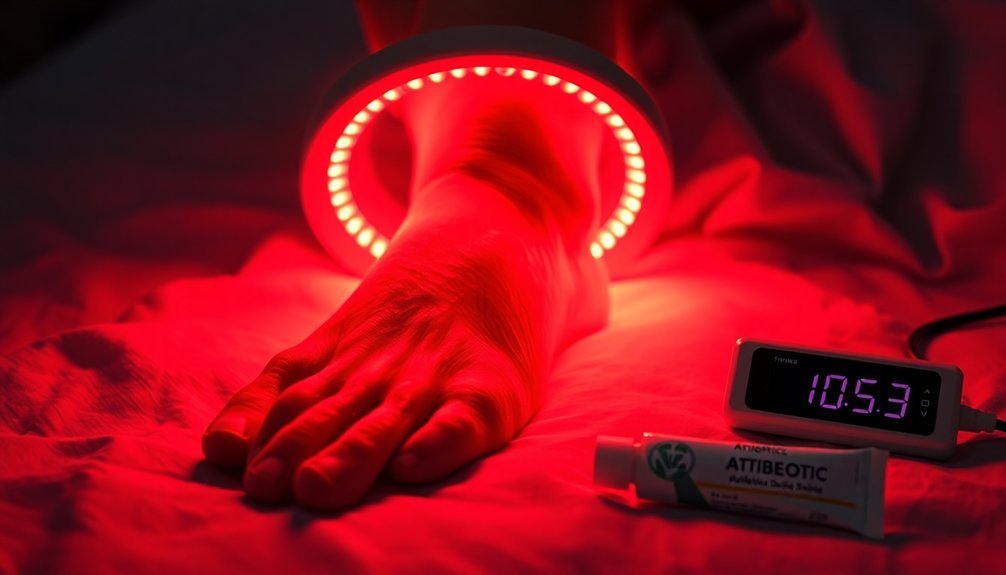
Building on established safety protocols, successful home treatment of diabetic wounds with red light therapy requires a structured approach you can reliably follow. You'll need to commit to daily 15-minute sessions, maintaining consistency for the best healing results.
If you're treating multiple areas, space out your sessions throughout the day to avoid overexposure.
It's essential that you use devices specifically designed for diabetes wound care, selecting high-quality units that deliver pure, uniform bioactive wavelengths. You'll want to follow the manufacturer's guidelines precisely while incorporating your healthcare provider's recommendations.
Before each session, verify you've properly cleaned and dressed your wound. You'll need to monitor your blood sugar levels regularly, as they directly impact healing.
During treatment, always protect your eyes and avoid excessive exposure to any single area.
You can enhance your results by combining red light therapy with other treatments. Whether you're using LLLT, conventional therapies, or pain management strategies, coordinate with your healthcare provider to develop an integrated approach.
They'll help you determine the most effective combination of treatments for your specific condition while guaranteeing you're using the therapy safely and effectively.
Success Stories
Consistently remarkable outcomes have emerged from various diabetic wound treatment approaches, with multiple case studies demonstrating substantial healing success.
You'll find that red light therapy, in particular, has shown impressive results when combined with traditional treatments, leading to complete healing over a four-month period without any side effects.
Evidence from multiple therapeutic approaches reinforces the effectiveness of these treatments. You can see this in cases where ultrasound therapy with microbubbles achieved complete healing of diabetic foot ulcers within 60 days, while maintaining normal liver and kidney function throughout the process.
A notable case showed how a large heel ulcer healed over 150 days using ultrasound and microbubble therapy, avoiding the need for skin grafting.
Daily jet lavage irrigation successfully created healing conditions in chronic wounds, especially when combined with hyperbaric oxygen therapy.
Red light therapy cases from the 1990s to 2000s demonstrated consistent success rates, particularly when used as a complementary treatment.
These success stories highlight how modern wound care approaches, especially when combined, can markedly improve healing outcomes for diabetic wounds.
Future Treatment Possibilities
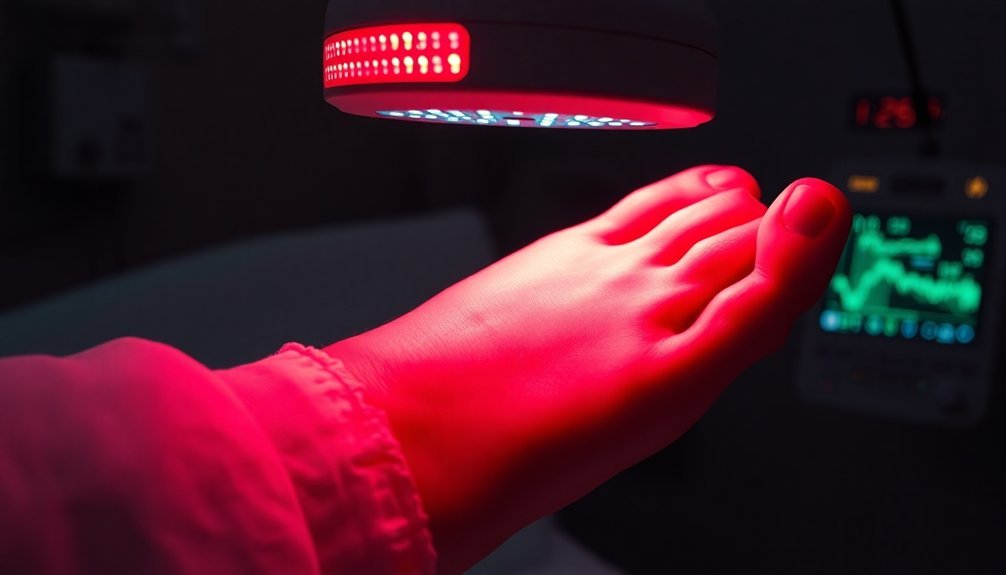
Three promising avenues are shaping the future of diabetic wound treatment, with photobiomodulation therapy (PBMT) leading the charge. You'll soon see combination therapies that pair PBMT with traditional treatments, enhancing overall healing outcomes. Research is already showing how different light wavelengths can be customized for your specific wound type and healing stage.
Scientists are developing more precise protocols for PBMT application, focusing on ideal dosages and timing. You'll benefit from new treatment guidelines that maximize healing while minimizing potential complications. The integration of LED technology with existing wound care practices will make treatments more accessible and cost-effective.
| Treatment Approach | Current Status | Future Potential |
|---|---|---|
| Combined Therapy | Early trials | Enhanced healing rates |
| Customized Wavelengths | Testing phase | Personalized treatment |
| Smart Devices | Development | Remote monitoring |
| Standardized Protocols | Research ongoing | Universal guidelines |
As research continues, you'll see more innovative applications emerge. The focus will be on preventing wound complications before they occur, using preventive PBMT treatments. You can expect to see smart devices that monitor your wound healing progress and automatically adjust light therapy parameters for best results.
Frequently Asked Questions
Can Red Light Therapy Prevent Diabetic Wounds From Recurring?
Yes, red light therapy can help prevent wound recurrence by boosting your circulation, reducing inflammation, and promoting collagen production. It'll strengthen your skin's healing ability and improve your tissue health long-term.
How Does Stress Affect the Effectiveness of Red Light Therapy?
When you're stressed, your body's healing response is compromised, which can reduce red light therapy's effectiveness. However, if you maintain regular sessions, the therapy can help counteract stress effects and maintain healing benefits.
Do Certain Medications Interfere With Red Light Therapy Results?
Yes, certain medications can interfere with your red light therapy results. You'll need to be careful with immunosuppressants, photosensitizing drugs, and medications affecting wound healing. Always consult your doctor before starting treatment.
Is Red Light Therapy Equally Effective for Different Skin Tones?
No, red light therapy isn't equally effective across skin tones. You'll need adjusted treatment protocols based on your skin type, with darker skin requiring lower intensities, longer sessions, and preferably NIR light for best results.
Does Age Impact How Well Diabetic Wounds Respond to Red Therapy?
While you'll experience slower healing as you age, red therapy remains effective for diabetic wounds across all age groups. It'll help counteract age-related challenges through enhanced cell regeneration and improved blood circulation.
In Summary
You'll find red light therapy offers a promising solution for diabetic wound healing through its proven ability to boost cellular repair and increase blood flow. While research continues to show positive results, it is crucial to follow proper safety protocols and consult your healthcare provider before starting treatment. Whether you're using it at home or in a clinical setting, you're looking at a non-invasive option with documented healing benefits.

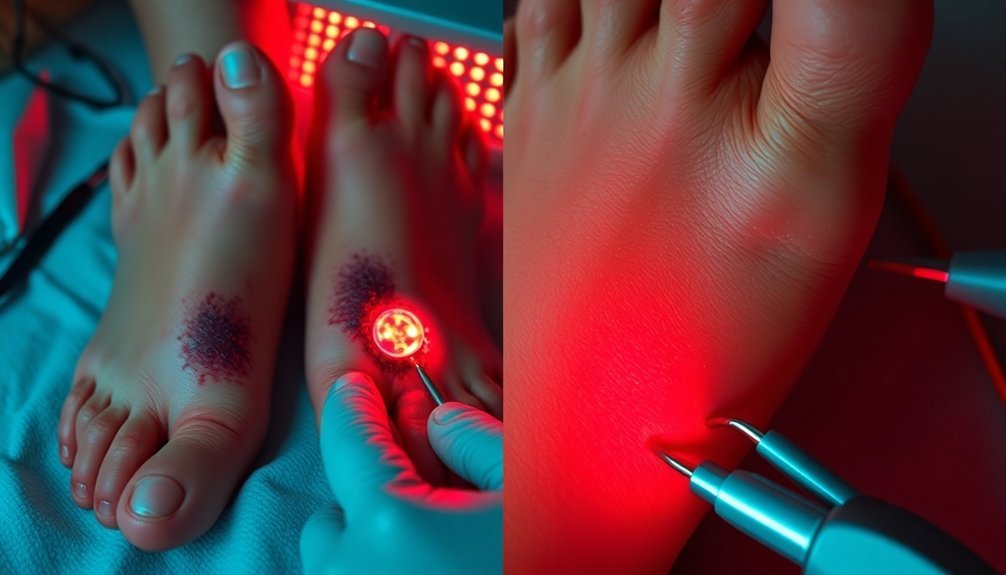



Leave a Reply